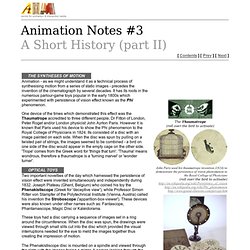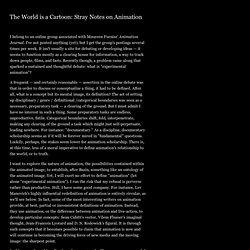

A Brief History of Motion Graphics.pdf. Phantasmagoria. 18th-century phantasmagoria Phantasmagoria ( American pronunciation , also fantasmagorie, fantasmagoria) was a form of theatre which used a modified magic lantern to project frightening images such as skeletons, demons, and ghosts onto walls, smoke, or semi-transparent screens, frequently using rear projection.

The projector was mobile, allowing the projected image to move and change size on the screen, and multiple projecting devices allowed for quick switching of different images. Invented in France in the late 18th century, it gained popularity through most of Europe (especially England) throughout the 19th century. History[edit] The magic lantern has been credited to both Athanasius Kircher[1] and Christiaan Huygens[2] both in the mid-17th century. Versailles was home to several significant developments in this field. After discovering that he could put the magic lantern on wheels to create either a moving image or one that increased and decreased in size, Robertson moved his show.
Animation History Part II. Animation - as we might understand it as a technical process of synthesising motion from a series of static images - precedes the invention of the cinematograph by several decades.

It has its roots in the numerous parlour-game toys popular in the early 1800s which experimented with persistence of vision effect known as the Phi phenomenon. One device of the times which demonstrated this effect was the Thaumatrope accredited to three different people, Dr Fitton of London, Peter Roget and/or London physicist John Ayrton Paris. However it is known that Paris used his device to show the Phi phenomenon to the Royal College of Physicians in 1824. Its consisted of a disc with an image painted on each side. When the disc was spun by pulling on a twisted pair of strings, the images seemed to be combined - a bird on one side of the disc would appear in the empty cage on the other side. These toys had a disc carrying a sequence of images set in a ring around the circumference.
Read on.... Pre-cinema. The World is a Cartoon: Notes on Animation. The World is a Cartoon: Stray Notes on Animation I belong to an online group associated with Maureen Furniss' Animation Journal.

I've not posted anything (yet), but I get the group's postings several times per week. It isn't usually a site for debating or developing ideas — it seems to function mostly as a clearing house for information, a way to track down people, films, and facts. Recently though, a problem came along that sparked a sustained and thoughtful debate: what is "experimental animation"? A frequent — and certainly reasonable — assertion in the online debate was that in order to discuss or conceptualize a thing, it had to be defined.
I want to explore the nature of animation, the possibilities contained within the animated image; to establish, after Bazin, something like an ontology of the animated image. Lev Manovich: Myth of Prodigal Return Manovitch's myth begins with an unassailably reasonable assertion. Manovich defines animation through a myth of prodigal return. Pixar's Zoetrope. Animation History Timeline. Animation History Timeline.